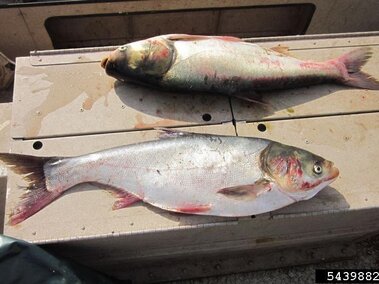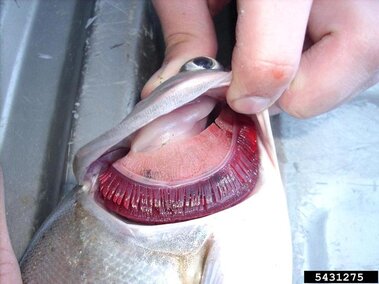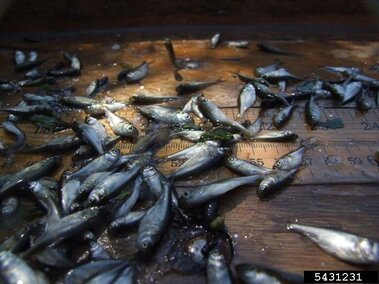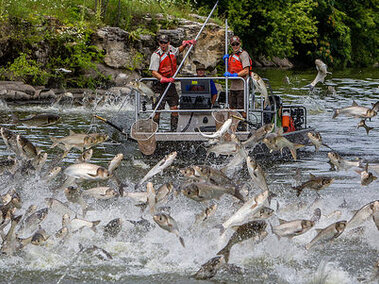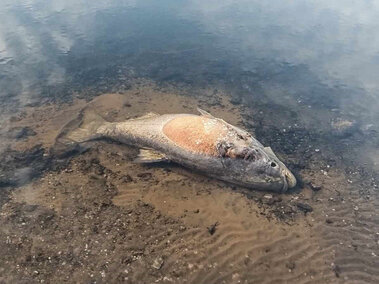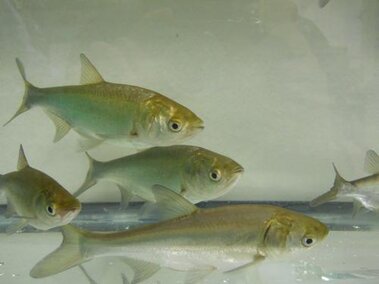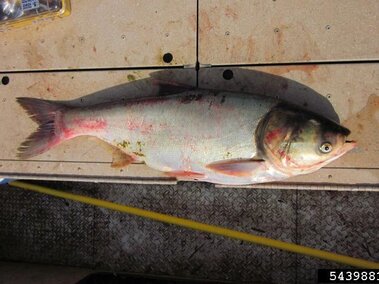Credit: Sam Stukel/USFWS, Public Domain
General Information
Species Name: Hypopthalmichthys molitrix
Also Known As: invasive carp
Family: Xenocyprididae (Sharpbelly)
Life Span: Commonly reach 3 to 5 years of age, but can live upwards of 15 to 20 years
Life Cycle: In its native range, silver carp mature by age 3 and live for as many as 8 years, whereas individuals in introduced areas, like the United States, appear to be reproducing by age 2 and only reach 5 years of age. Adults breed in rivers or tributaries over shallow rapids with gravel or sand bottom, in upper water layer or even at surface during floods when the water level rises. Juveniles and adults form large schools during spawning season. Mature individuals undertake long distance upriver migration at start of a rapid flood and water-level increase. After spawning, adults migrate to foraging habitats and in autumn, adults move to deeper pools of the main river. Larvae drift downstream and settle in floodplain lakes, shallow shores and backwaters with little or no current where the develop before migrating as adults to habitats such as main and side channel borders.
Origin: Asia
Injurious: Yes. Currently under the Lacey Act, silver carp are listed as injurious wildlife by the U.S. Fish and Wildlife Service, which prohibits the importation into or transportation between the continental United States, the District of Columbia, Hawaii, the Commonwealth of Puerto Rico or any territory or possession of the United States of live silver carp, gametes, viable eggs and hybrids.
Category 2: Priority Aquatic Invasive Species
Why Are They Invasive?
Silver carp feed by filtering phytoplankton and zooplankton from the water using specialized gill structures. This reduces the amount of food available to native aquatic species. They can also carry and transmit the disease Salmonella typhimurium. They are known for acrobatic jumping out of the water up to 9 feet (3 meters) when startled by the noise of boat motors, becoming potential hazards for recreational boaters.
What Do They Look Like?
The silver carp is a narrow, deep-bodied fish that is laterally compressed that as a large, toothless mouth with upturned lower jaw and lacks barbels. Their bodies are very silvery in color, especially when young, and later develop a greenish hue on their back to silver on the belly as they age. Their scales are small, and trout-like while their heads are scaleless. Their eyes are situated far forward on the head, sit below the mouth and project downwards. They can be distinguished from bighead carp due to their keel which extends along the belly from their anal fin to the base of their gills whereas bighead carp have keels that only extend from their anal fin to pelvic fin, and their pectoral fins only extend to the base of their pelvic fin as opposed to beyond the pelvic fin in bigheads. They can grow upwards of 3 feet in length. Individuals commonly reach 20 pounds with the largest individuals reaching upwards of 80 to 90 pounds.
Photos
Where Do They Live?
Silver carp occur in a variety of freshwater habitats, including large rivers and warm-water ponds, lakes and backwaters that receive flooding or are otherwise connected to large rivers. They also have been introduced widely to ponds, lakes, reservoirs and canals, where they have been reported to thrive but probably can’t reproduce without access to an appropriate riverine habitat. They prefer open areas of standing or slow-flowing waters and occupy the upper and middle layers of the water column. In the United States, they prefer contiguous backwaters, tributary streams, main-channel borders, side-channel borders, behind wing dikes and slow-flowing portions of large rivers, where water may pool. They avoid main-channel habitat. Silver carp are quite tolerant of broad water temperature ranges, from 4 °C to 40 °C. Silver carp are known to feed at water temperatures of 10 to 19 °C; in the Missouri River, silver carp sometimes had full guts at temperatures lower than 4 °C. Although they’re a freshwater species, they can also live in slightly brackish water and tolerate salinities ranging from 1.5 to 12%. They can be found in the Mississippi, Missouri, Ohio, Tennessee and Cumberland rivers and many of their tributaries. They have been reported in states such as Alabama, Arkansas, Illinois, Indiana, Iowa, Kansas, Kentucky, Louisiana, Minnesota, Mississippi, Missouri, Nebraska, Nevada, North Dakota, Ohio, Oklahoma, South Dakota, Tennessee, Texas and Wisconsin. In Nebraska, they are found in the Missouri, Loup, Elkhorn, and Platte Rivers.
How Do They Spread?
Silver carp have successfully invaded the Mississippi River and it’s tributaries after being accidentally introduced from aquaculture and waste water treatment ponds during the 1970s and 1980s.
How Do I Control Them?
Management of invasive fish involving either mechanical removal or application of chemicals to public waters requires a permit. Contact the Contact the Nebraska Game and Parks Commission for more information.
CLEAN your watercraft, trailer, angling gear and other equipment. Remove all aquatic vegetation and animal species from your equipment.
DRAIN your watercraft at the ramp by removing the boat plug and draining all live wells and ballast tanks.
DRY your watercraft, trailer and other equipment for at least 7 days before visiting another waterbody.
DON'T DUMP BAIT. Dispose of bait by emptying bait buckets on dry land, away from waterbodies or in a trash receptacle. Moving a live organism from one waterbody to another is illegal, even if you are planning to use the organism as bait.
DON'T LET IT LOOSE. Do not release or transport exotic or non-native fish species to new ecosystems. It is unlawful to release any aquatic species into a waterbody other than the one from which it was harvested. Doing so can promote the spread of AIS.
What Should I Do If I See Them in Nebraska?
If you see silver carp in Nebraska, you should report them to the Nebraska Game and Parks Commission's Aquatic Invasive Species (AIS) Program using their AIS Report Form. For guidance on what information to include in your report, check out our reporting tips.
References and More Information
Center for Invasive Species and Ecosystem Health
Fowler, E. (2021). Carp Roundup. Nebraskaland Magazine/Nebraska Game and Parks Commission.

